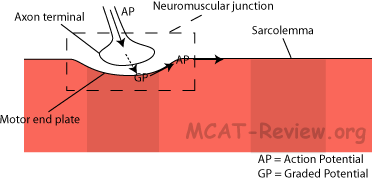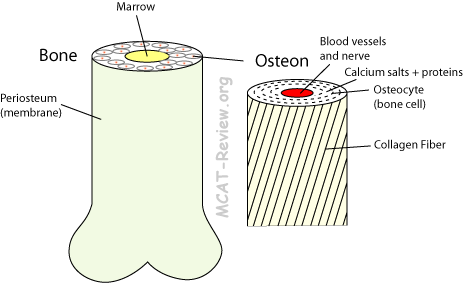|
|
Muscle System
- Functions
- support, mobility
- Support = muscles maintain your posture when you sit/stand, muscles also stabilize joints, help prevent dislocations.
- Mobility = you move because of skeletal muscles. Your guts move because of smooth muscles. Your blood flow because of pumping action of the heart.
- peripheral circulatory assistance
- Heart is a muscle that pumps blood.
- Contraction of skeletal muscles around the deep veins help squeeze the blood through those veins.
- Diaphragm contraction (breathing) sucks blood into the chest cavity, and also squeezes on abdominal veins.
- thermoregulation (shivering reflex)
- Muscles generate heat when you shiver in response to cold.
- Structural characteristics of skeletal, smooth, and cardiac muscle; striated vs nonstriated

- Skeletal muscle = striated, voluntary, shaped like long fibers, multinucleated.
- Smooth muscle = nonstriated, involuntary, shaped like almonds (tapered ends), one nucleus per cell.
- Cardiac muscle = striated, involuntary, branched, shaped like fibers cross-linked to one another, typically one nucleus per cell.
- Striated = due to sarcomere structure (A bands dark, I bands light). Skeletal and cardiac muscles have sarcomeres.
- Nonstriated = smooth muscles don't have sarcomeres so they're not striated. They still have myosin, actin, and use the sliding filament mechanism. They just are not organized into sarcomeres.
- Read more about sarcomeres here.
- Nervous control
- motor neurons = efferent neurons = signals muscles/organs to do stuff = the opposite of sensory neurons.
- Somatic motor neurons = controls skeletal muscles.
- Autonomic motor neurons = sympathetic and parasympathetic divisions = controls involuntary (smooth, cardiac) muscles.
- neuromuscular junctions, motor end plates

- neuromuscular junction = nerve (axon terminal) meets muscle (motor end plate).
- motor end plate = part of muscle cell membrane (sarcolemma) that synapse with the motor neuron, has receptors for the neurotransmitters.
- what happens at the neuromuscular junction? Action potential of nerve reach axon terminal → release neurotransmitters into synapse → receptors on motor end plate (sarcolemma) picks this signal → graded potential created → if reaches threshold, then action potential created → action potential travels down the sarcolemma and cause muscle to contract.
- voluntary and involuntary muscles
- voluntary = you can control = skeletal muscles, eg. Biceps.
- involuntary = you can't control = smooth (eg. gut) and cardiac (heart) muscles.
- sympathetic and parasympathetic innervation
- sympathetic = fight or flight = heart beat faster, pupil dilation, raise blood pressure, blood to muscles, less blood to digestive system.
- parasympathetic = rest and digest = opposite of sympathetic = heart slower, pupil constriction, lower blood pressure, blood to digestive system.
- Both sympathetic and parasympathetic are motor neurons that innervate involuntary muscles.
Skeletal System
- Functions
- structural rigidity and support: bone forms the body's framework.
- calcium storage: bone stores calcium. When blood calcium is low, parathyroid hormones signal bone tissue to break down and release calcium.
- physical protection: rib cage protects internal organs. Skull protects brain. Spine protects spinal cord. Many large bones also shelter bone marrow that contains stem cells that make blood.
- Skeletal structure
- specialization of bone types, structures
- Long bones: shaped like a rod. eg. arm, leg, finger bones.
- Short bones: shaped like a cube. eg. wrist, ankle bones.
- Flat bones: bones that are flat. eg. sternum, shoulder blades, ribs, skull.
- Irregular bones: complicated shapes. eg. vertebrae, hip.
- joint structures
- Joint = where bone meets bone.
- Joints can be mobile or non-mobile.
- Mobile joints (synovial) have a fluid-containing cavity to lubricate movements of the bones.
- Non-mobile joints connect bone to bone with cartilage or fiber.
- Ball and socket joint: shoulder, hip.
- Hinge joint: elbow.
- Gliding joint: wrist.
- Immobile joint: plates of the skull, rib-to-sternum.
- The joint type that allows most freedom of movement = ball-and-socket.
- endoskeleton versus exoskeleton
- Endoskeleton = what we have, skeleton on the inside.
- Exoskeleton = what insects have, skeleton (chitin) on the outside.
- Cartilage (structure and function)
- Cartilage = cells + extracellular matrix.
- Cartilage cells = chondrocytes.
- Extracellular matrix = secreted by the cells, contains fiber meshworks that give the cartilage its characteristic properties (flexibility and resilience)
- Functions
- Flexibility: ear, nose, epiglottis, end of ribs
- Resilience, compressibility: Ends of bones in joints, knee, between vertebrae.
- Ligaments, tendons
- Ligament = connect bone to bone, stabilize joints.
- Tendon = connect muscle to bone, anchors muscle.
- Bone structure

- Macroscopically: bone = solid strucuture with canals inside where blood vessel runs, and holes where cells can reside, the whole thing surrounded by membrane that contains stem cells (osteoblasts) and osteoclasts.
- Microscopically: bone = cell + extracellular matrix = arranged in cylinders called osteons, with blood vessel and nerve running through the middle of the cylinder.
- Cell = osteocytes (bone cells).
- calcium-protein matrix: the extracellular matrix of bone consists of calcium salts, collagen fibers, and ground substance (glue).
- bone growth (osteoblasts, osteoclasts)

- Growth in length:
- Lengthwise bone growth occurs at the ends of long bones at the knobs.
- Osteoblasts' role in lengthwise bone growth is to add bone tissue at the bone ends.
- By itself, osteoblasts will lengthen the knobs at the ends of the bone.
- Osteoclasts' role in bone growth is to remodel bone tissue by chipping away the knobs until it's the right size and shape.
- Growth in diameter:
- Osteoblasts' role in diameter growth of bones is to add bone tissue to the outside of the bone.
- Osteoclasts' role in diameter growth of bones is to remove some bone tissue from the inside of the bone (bones are hollow).
- Without osteoclasts, diameter growth will result in bones that are too thick and too heavy. Even with osteoclasts, bones still grow thicker, just not unwieldly thick.
- Osteoblasts vs osteoclasts vs osteocytes
- Osteoblasts = stem cells that give rise to osteocytes = builds bone.
- Osteocytes = mature bones cells = reside in bone for housekeeping.
- Osteoclasts = large cells that break down bone.
|
|
